The Theories Defined
- All behavior learned by positive reinforcement;
- People learn by modeling, observation, and imitation.
All behavior can be learned if positively reinforced.
There is no punishment, only taking away desired reward.
Social learning: people learn from each other.
By observation, imitation and modeling (McAdams, 2006).
McAdams, D. (2006). The person: A new introduction to personality psychology. (4th ed.). Hoboken, NJ: John Wiley & Sons.
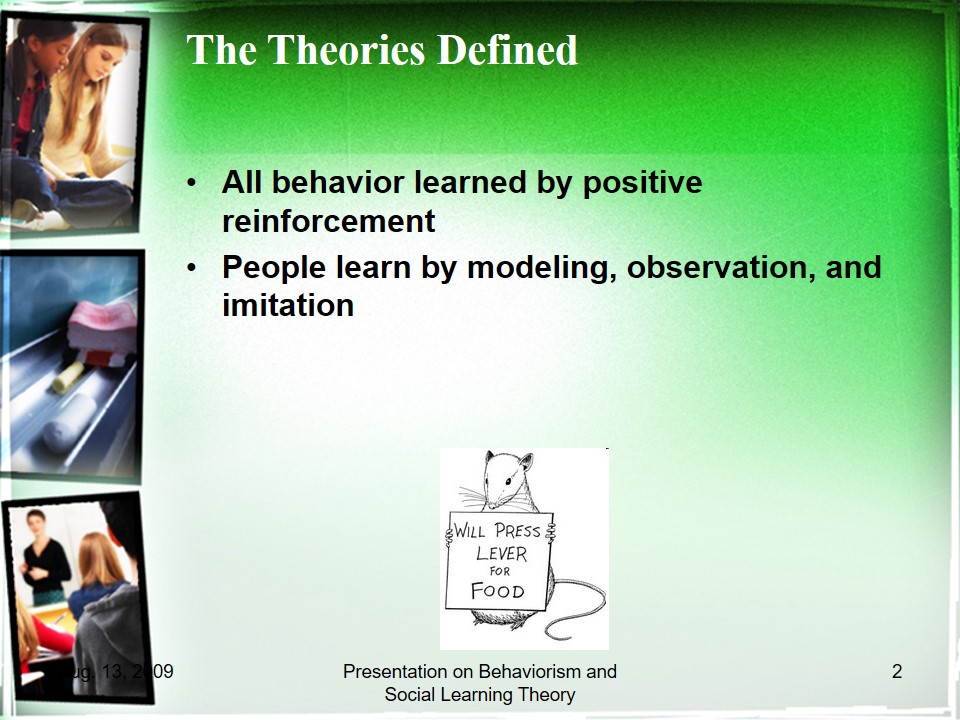
The Roots of Behaviorism
- The “blank slate” claim.
- There is no inherent personality, talent.
- No will, intent or personal responsibility.
- Learn anything and be anyone.
- Only external stimuli matter.
- Locke’s tabula rasa and utilitarianism.
- Watson’s behaviorism.
- Pavlov’s conditioned stimulus.
- There is no inherent personality.
- Neither are there inborn differences in talent.
- Thoroughly “proven” in laboratory animals.
- No will, intent or personal responsibility.
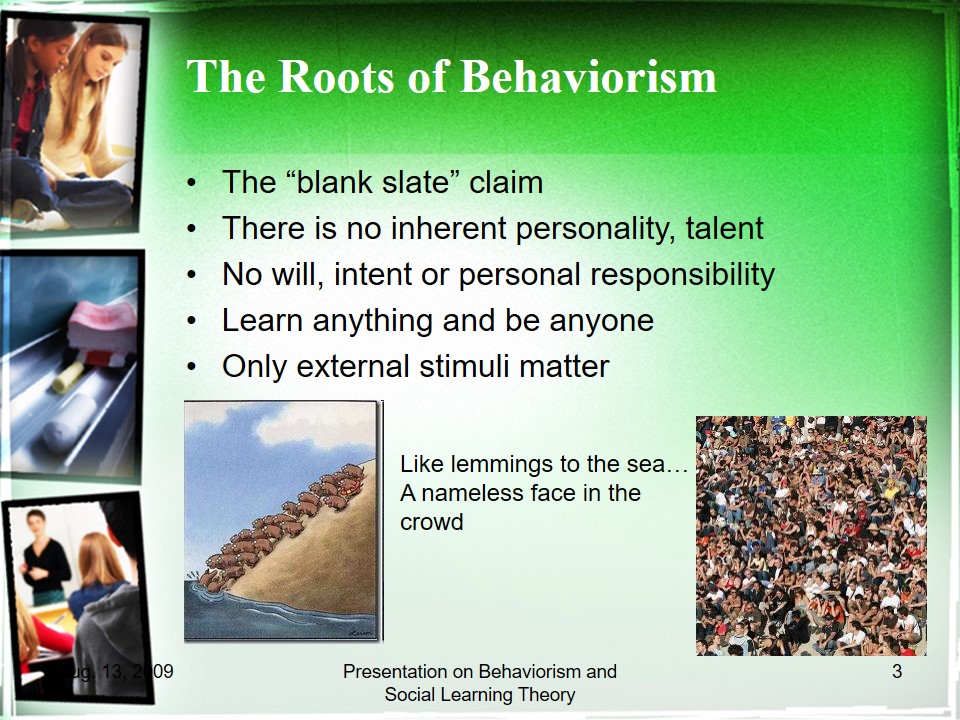
Skinner’s Totally Pliable Laboratory Animals
- In a Skinner Box.
- Animals can learn or avoid anything.
- With positive reinforcement.
- Or adversive stimulus.
- High learning rates, obsessively so.
- Rats in the Skinner Box.
- Positive reinforcement: food and water.
- Adversive stimulus: electric shock.
- Repeatedly exhibit behavior, to the point of obsession.
- Explained by either external stimulus.
- Or physiological change.

The Trouble with People…
- Skinner made the jump from rats to his own daughter;
- Classical conditioning = simple learning;
- Pleasure/Pain alone cannot explain child development;
- Behavior is extinguished if positive reinforcement no longer delivered?
- Forgetting that intermittent reinforcement is the most durable;
- Moral mandate more effective than:
- “Discriminant stimuli”;
- “Generalization”;
- Society’s ultimate good brings the most pleasure.
Classical conditioning explains only simple learning.
Because child development combines cognitive, affective and motor development over a very long time.
At least for rats and pigeons. And possibly recidivist criminals.
Contrary to how the Epicureans invoked greater good, humans more likely swayed by instant gratification, the pleasure of the moment.
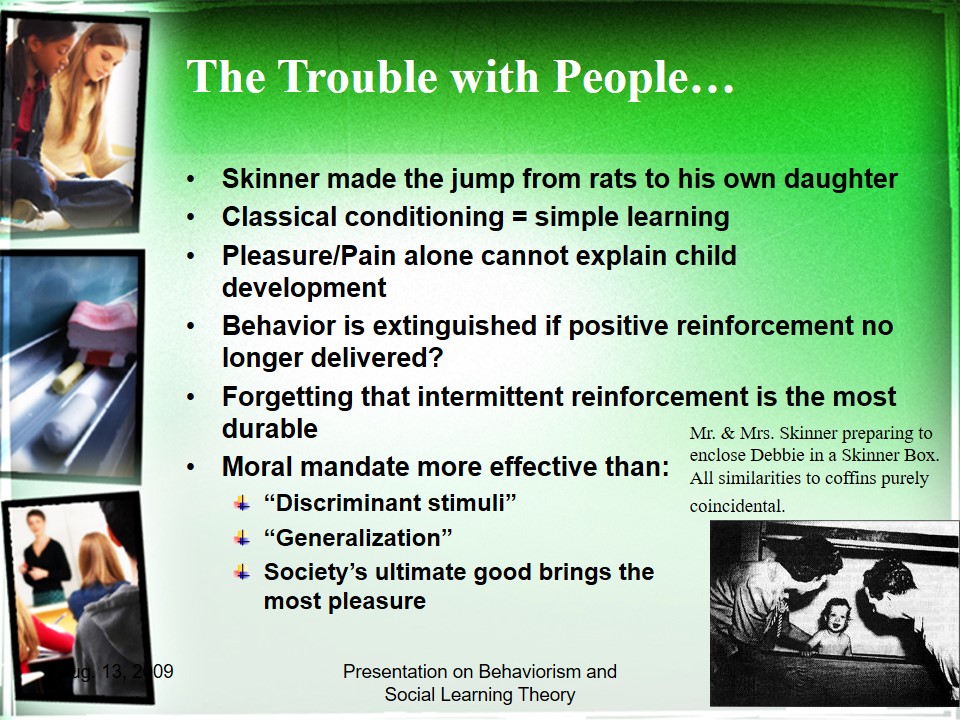
The Essence of Bandura’s Social Learning Theory
- Attention, memory and motivation.
- Reinforcement.
- Constant interaction among cognitive, behavioral, environmental influences.
- Accommodates attention, memory and motivation.
- Reinforcement = absorbing the consequences for others.
- Constant interaction among cognitive, behavioral, environmental influences.
- This explains both interpersonal and intergenerational violence.
- As well as uncontrolled learning from the Internet, for both violence and pornography.

Social Modeling Requires
- Attention modified by:
- Attributes of external influence (1);
- One’s characteristics (2);
- Retaining what caught your attention (3);
- Reproducing the absorbed image (4);
- Strongly motivated to replicate (5);
- Distinctiveness, affective valence, prevalence, complexity, functional value.
- E.g. sensory capacities, arousal level, perceptual set, past reinforcement.
- Includes symbolic coding, mental images, cognitive organization, symbolic rehearsal, motor rehearsal.
- Including physical capabilities, and self-observation of reproduction.
- Having a good reason to imitate. Includes motives such as past (i.e. traditional behaviorism), promised (imagined incentives) and vicarious (seeing and recalling the reinforced model).
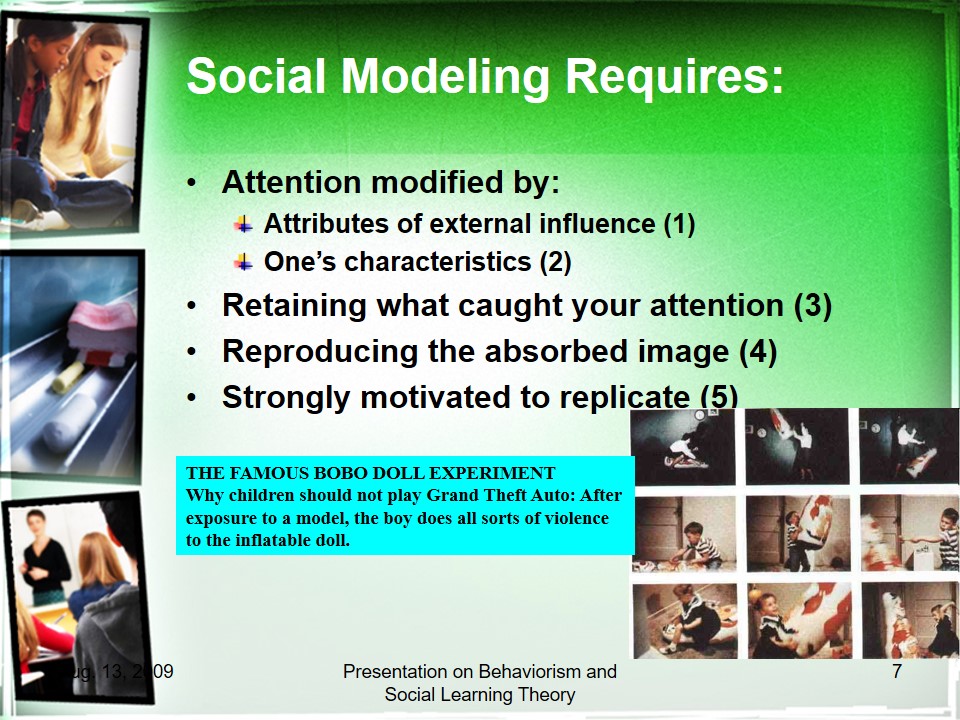
Social Learning and Behaviorism
- Behavior responds to the environment.
- And modifies the environment.
- Personality and psychological processes mediate the behavior-environment interaction.
- Behavior not explained solely by externals.
- The environment and external stimuli.
- Behavior also modifies the environment.
- For example, adolescent rebellion and aggression.
- Personality and psychological processes mediate the behavior-environment interaction.
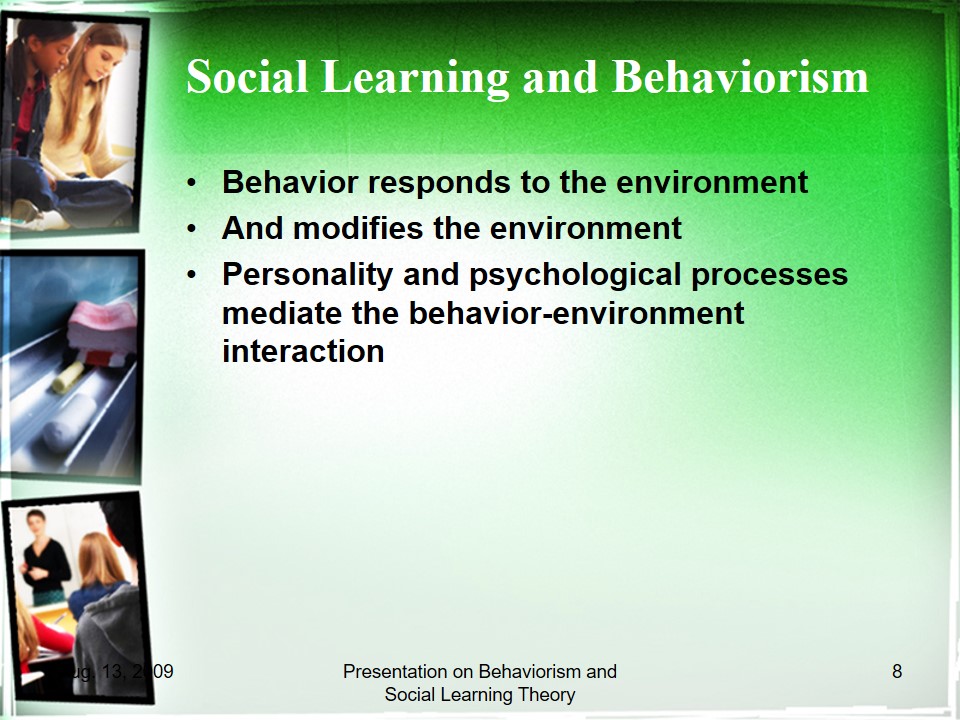
The Implications for American Environmentalism
- Can’t generalize from pigeons and rats.
- If man product solely of environment.
- He is not ultimately responsible.
- Logical end-result: close all jails, release sex offenders back to the community.
- Human cognition no different from pigeons and rats (Richelle, 1995).
- Man is product solely of the reinforcements he received while growing up.
- Or the social learning he is exposed to.
- He is not ultimately responsible.
- There are no hard-and-fast moral rules.
- Only situational ethics.
Richelle, M. (1995). B.F. Skinner: A reappraisal. East Sussex, UK: Psychology Press.
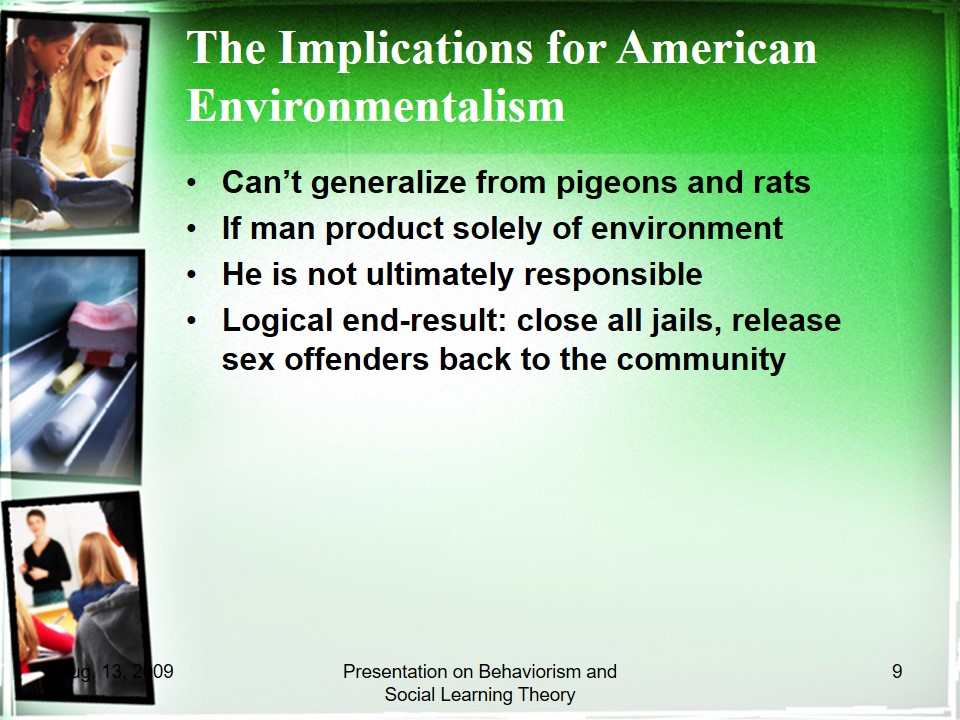
Troubling Questions about Skinner’s Walden Two
- Who is to say what is desirable?
- You can’t wait for desired behavior
- Turns out emotions also exist (Skinner)
- How control the stimuli that impinge on man?
- What about the overriding moral imperative?
- Who defines what is socially desirable?
- Is there a moral imperative after all? (Rand, 1984).
- Wait for desired behavior or teach it?
- You can’t wait, you must teach (e.g. sex education).
- Why bother then with emotional control?
- Is communal control possible in the age of vast communication possibilities?
Rand, A. (1984). The stimulus and the response: Who needs it? In, Philosophy: Who needs it? New York: Signet Books. Chapter 13.

Human Consciousness Overrides Pleasure and Social Pressure
- Man aspires to be more than hedonist.
- Or pliant social animal.
- There are moral absolutes.
- And legal ones desired by the community.
- Man aspires to be more than hedonist.
- Or pliant social animal.
- Judaeo-Christian religion: “Thou shalt not kill”.
- Even if your enemy be pagan “infidel”.
- Even if aborting the fetus relieves you of consequences.
- The law: No drugs, period. DUI kills, don’t do it.
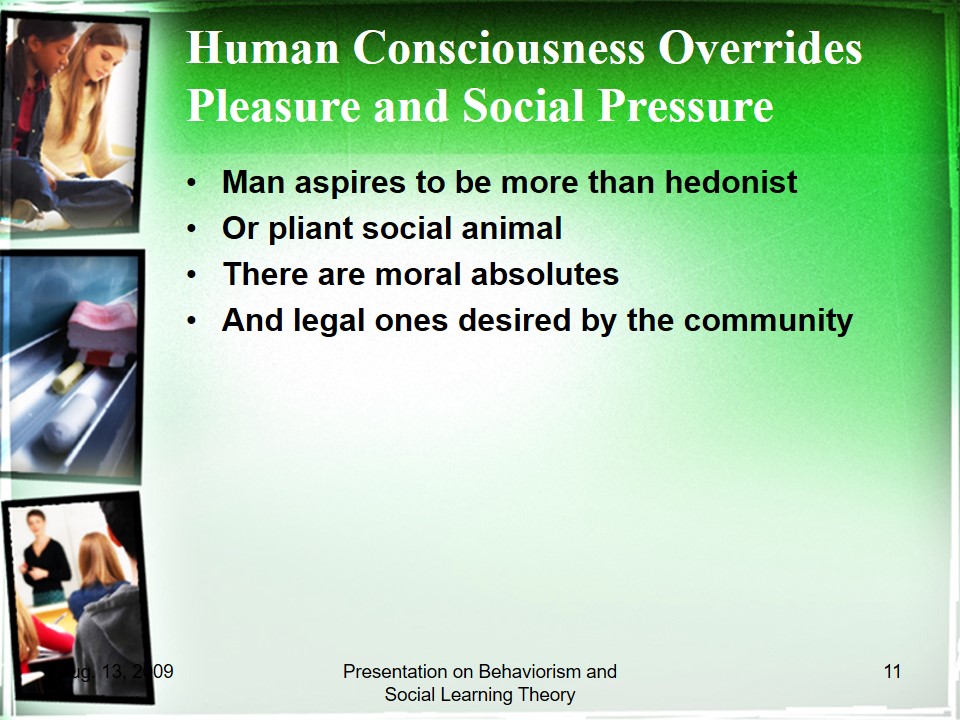
Beyond Social Learning
- Social models not good enough.
- Biased media and the Net full of shoddy models.
- Neither behaviorism nor social learning fully explain.
- Man’s craving to be altruistic.
- Across all strata.
If “duty, honor and country” depends on social context alone
Why is it a universal truth?
Are war resisters the right model? Or a product of media bias?
Where is the behaviorist and social value in helping the disadvantaged?
If spirituality and religion do not matter, why volunteer for missionary duty?
Answer: To be human is to be altruistic
Beyond the limitations of income, gender, personality, talent and context.
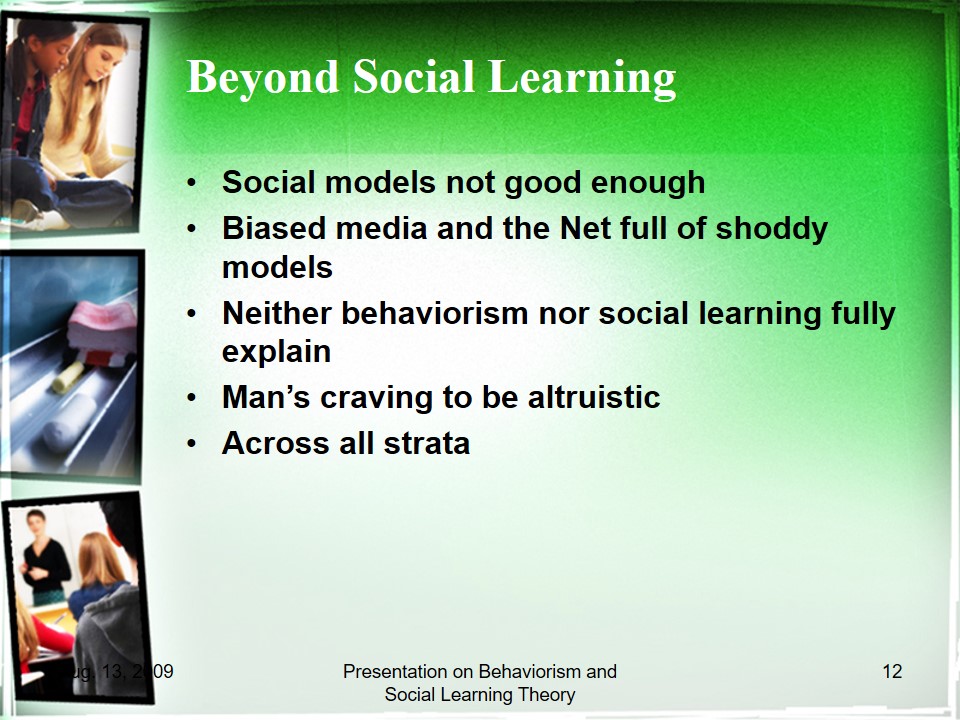
“Love is worth waiting for”
- Why have adolescents responded?
- Despite peer pressure and tacit consent?
- Don’t behaviorism and social learning say, “Pleasure now!”?
- But there is postponed gratification
- Humans are not rats and pigeons
- To be a person is to own freedom and dignity
Why does this strike a compelling chord?
Isn’t peer pressure all-powerful?
Don’t parents and school authorities tacitly condone adolescent sex? (Society for Adolescent Medicine, 2006).
Behaviorists say, it is coercive to withhold contraceptive information.
Don’t behaviorism and social learning agree, “Pleasure now!”?
Answer: neither theory accommodates postponed gratification.
Making hard choices = cements the ability to stay on the path to maturity.
Humans are not animal instinct and social learning solely.
We own the freedom and dignity behaviorism and social learning deny.
Society for Adolescent Medicine (2006). Abstinence-only education policies and programs: A position paper. Journal of Adolescent Health, 38: 83-87.
